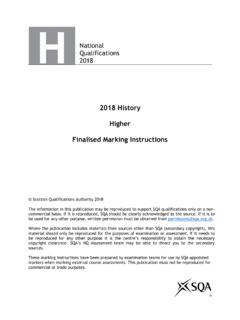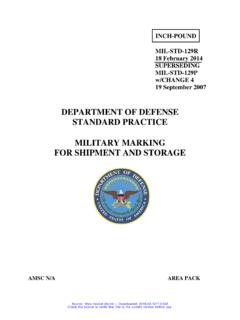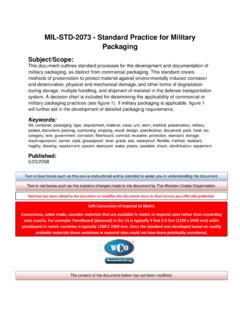Transcription of Understanding Military Specification & Standard Requirements
1 Understanding Military Specification & Standard Requirements What does it all mean? David L. Melton, Managing Member Business Development Zone, LLC TWO LOCATIONS: Columbia City Office Fort Wayne Office Bruce Stach David L. Melton, Managing Member Managing Member Business Development Zone Business Development Zone 3344 East 500 North 3182 Mallard Cove Lane Columbia City, IN 46725 Fort Wayne, IN 46804 Phone: 260-417-1507 Phone: 260-414-9180 Business Development Zone, LLC Page 1 TABLE OF CONTENTS 1 Introducion .. 2 2 Military Specifications and Standards .. 2 Overview ..2 Definition of document types .. 3 Origins and evolution.
2 4 DoD s Single Stock Point of Information [DoD Single Stock Point (DODSSP)]..5 Streamlining Mil Spec ASSIST ..6 Acquisition Streamlining and Standardization Information System (ASSIST) .. 6 ASSIST-Quick Search; ..6 3 American National Standards Institute (ANSI) .. 10 History .. 10 Members .. 11 Process .. 11 International activities .. 12 4 ASTM International .. 12 History .. 13 Standards .. 13 Membership and organization .. 14 Standards compliance .. 14 5 Summary & Conclusions .. 15 Business Development Zone, LLC Page 2 1 Introducion The purpose of this document is to familarize you with the Department of Defense s use of Standards and Specifications.
3 For a given DoD solicitation you will find most references to Standards and Specifications in SECTION C DESCRIPTION/SPECFICICATIONS/STATEMENT OF WORK of the solicitation document. The one exception to this format is the Requirements for Packaging and marking which are contained in SECTION D. SECTION C describes the work to be performed and the technical Requirements for the deliverable items. When reading Section C: Look for Requirements (are they explained, understandable, and/or ambiguous?), contradictions (between Requirements as well as Section L and M), feasibility, and opportunities for differentiation between you and your competitors.
4 Section C; Can contain background information about the agency issuing the solicitation. Purpose and objectives of the requirement. Addresses what the seller must do to perform the contract. States minimum and mandatory Requirements Statement of work/Scope of work. This is a description and the specifications of what is wanted by the Agency Department. Usually this is in great detail. It may contain material, equipment and personal Requirements in addition to safety quality assurance items. Also called scope of work. It can contain detailed responses, usually matrices and spreadsheets to depict the man-hours, frequency of work, etc. The DoD solicitation document will not only call out Military Specifications and Standards, but may also reference other recognized standards like The American National Standards Institute (ANSI, / nsi / AN-see) and ASTM International, known until 2001 as the American Society for Testing and Materials (ASTM).
5 This document will provide a brief overview of these three referenced Requirements . 2 Military Specifications and Standards Overview A United States defense Standard , often called a Military Standard , "MIL-STD", "MIL-SPEC", or (informally) "MilSpecs", is used to help achieve standardization objectives by the Department of Defense. Business Development Zone, LLC Page 3 Standardization is beneficial in achieving interoperability, ensuring products meet certain Requirements , commonality, reliability, total cost of ownership, compatibility with logistics systems, and similar defense-related objectives. Defense standards are also used by other non-defense government organizations, technical organizations, and industry.
6 This article discusses definitions, history, and usage of defense standards. Related documents, such as defense handbooks and defense specifications, are also addressed. Definition of document types Although the official definitions differentiate between several types of documents, all of these documents go by the general phrase of " Military Standard ", including defense specifications, handbooks, and standards. Strictly speaking, these documents serve different purposes. According to the Government Accountability Office (GAO), Military specifications "describe the physical and/or operational characteristics of a product", while Military standards "detail the processes and materials to be used to make the product.
7 " Military handbooks, on the other hand, are primarily sources of compiled information and/or guidance. The GAO acknowledges, however, that the terms are often used interchangeably. Official definitions are provided by DoD , [2], Defense Standardization Program (DSP) Policies and Procedures, March 2000, OUSD (Acquisition, Technology and Logistics): Acronym Type Definition MIL-HDBK Defense Handbook A guidance document containing Standard procedural, technical, engineering, or design information about the material, processes, practices, and methods covered by the DSP. MIL-STD-967 covers the content and format for defense handbooks. MIL-SPEC Defense Specification A document that describes the essential technical Requirements for purchased materiel that is Military unique or substantially modified commercial items.
8 MIL-STD-961 covers the content and format for defense specifications. MIL-STD Defense Standard A document that establishes uniform engineering and technical Requirements for Military -unique or substantially modified commercial processes, procedures, practices, and methods. There are five (5) types of defense standards: interface standards, design criteria standards, manufacturing process standards, Standard practices, and test method standards. MIL-STD-962 covers the content and format for defense standards. MIL-PRF Performance Specification A performance Specification states Requirements in terms of the required results with criteria for verifying compliance, but without stating the methods for Business Development Zone, LLC Page 4 achieving the required results.
9 A performance Specification defines the functional Requirements for the item, the environment in which it must operate, and interface and interchangeability characteristics. MIL-DTL Detail Specification A Specification that specifies design Requirements , such as materials to be used, how a requirement is to be achieved, or how an item is to be fabricated or constructed. A Specification that contains both performance and detail Requirements is still considered a detail Specification . Origins and evolution Defense standards evolved from the need to ensure proper performance, maintainability and reparability, ease of maintenance-repair-overhaul (MRO), and logistical usefulness of Military equipment.
10 MRO may be defined as, All actions which have the objective of retaining or restoring an item in or to a state in which it can perform its required function . The latter two goals (MRO and logistics) favor certain general concepts, such as interchangeability, standardization (of equipment and processes, in general), cataloguing, communications, and training (to teach people what is standardized, what is at their discretion, and the details of the standards). For example, due to differences in dimensional tolerances, in World War II American screws, bolts, and nuts did not fit British equipment properly and were not fully interchangeable.







